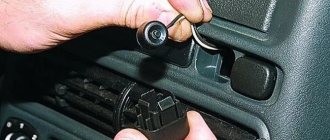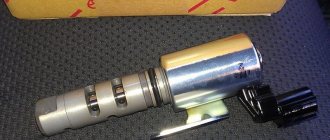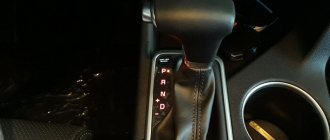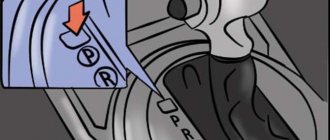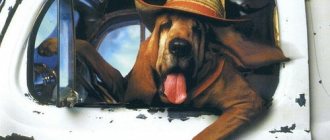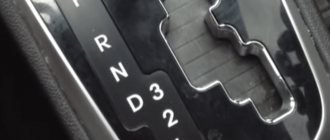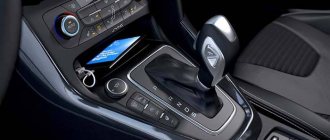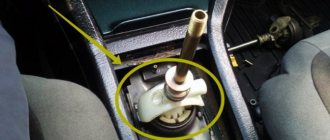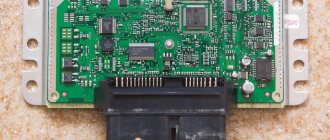Features of the functioning of the 4th century automatic transmission.
The automatic transmission allows you to change the gear ratio along with the speed of the vehicle without driver intervention.
The range selection lever has an alphabetic and numerical designation. This type of transmission has a long service life. Also, it allows you to effectively slow down and restrain vehicles on an ascent or descent. When O/D is activated, the automatic transmission shifts sequentially from 1st to 4th gear. Overdrive mode blocks 4th gear, the car moves only in 3rd. At the same time, rapid acceleration is noted. Overdrive can be considered an analogue of the 5th gear of a standard manual transmission. When it is turned off, the O/D off message will light up on the instrument panel.
Switching to 4th occurs while driving, when the speed begins to exceed 45 km/h. When overdrive is turned on, when acceleration occurs, the transmission will sequentially shift from first to fourth gear, after which the torque converter lock-up is activated. As a rule, it is not possible to travel around the city at a constant speed. This is due to the fact that you have to stop frequently at traffic lights.
What is automatic transmission overdrive mode
How to install a turbo timer on a diesel enginePost navigationSearchPopularLegal consultationInformationFree legal consultation
The selector can be controlled in several modes: There are also modes 2 or 3, in which it is possible to move forward in two or three gears, respectively. Typically, such modes are turned on when overcoming difficult road sections, as well as for more effective engine braking.
L – Driving is possible only in low (first) gear. Used when overcoming difficult sections of roads, during long descents. While driving, you cannot move the selector from position D to L, that is, you must start moving from there.
Now comes the most interesting part - electronic modes.
Let's look at one of them in more detail. Note that when the overdrive button on the automatic transmission is pressed, the indicator does not light up, but the function works. When this button is disabled, the “o/d off” indicator on the instrument panel lights up in yellow or orange.
And it's bad for work.
The car brakes very weakly with the engine, this happens because the engine turns less.
Overdrive is good to use when driving on the highway. Experts and manufacturers recommend turning on the overdrive mode in the automatic transmission in the following cases:
- when accelerating the car, for example, when you overtake and move over 100 km/h;
- when you are driving on a bad road or even off-road;
- you are slipping a heavy trailer.
Despite many different opinions, it is also recommended to turn on overdrive in the city. This will not be difficult; the button on the lever will do it for you. The button is called O/D (on|off).
- you go up and down (long descent);
- when the pace of traffic on the road is constantly changing;
- if you drive less than 50 km/h.
It is also recommended to turn it on when:
- you are driving on the highway;
- eat for a long time without changing speed;
- you drive at high speeds, for example, over 120 km/h.
The off mode is displayed on the control panel. Opinions about this innovation are very different, some are for, some are against. Let's try to figure this out.
Overdrive is the highest (overdrive) gear of an automatic transmission (automatic transmission), and is analogous to the 5th gear of a manual transmission (manual transmission).
Sometimes overdrive needs to be turned off (press a button), in which case the O/D OFF indicator lights up on the dashboard.
It should be remembered that our transmission (and the car in general) forgets about the overdrive being turned off when you turn off the car (ignition key to the LOCK position).
Those. after you start your car again, all 4 gears work!
Why doesn't the Overdrive button work?
The overdrive button may not work for a number of reasons. Like any other mechanism in a car, the overdrive button on an automatic transmission has its own resource, and can fail during intensive use, simply due to physical wear and tear (which is extremely rare in practice).
The most common reason for the failure of the O/D button is broken wires or poor contact on the connector going to the button. In this case, the problem can be resolved by disassembling the automatic transmission shift knob and restoring the integrity of the wiring.
If everything is fine with the button itself, the wires and connectors are intact, then the problem may be much more serious. In particular, you should check the overdrive sensor and diagnose the automatic transmission itself.
Why do you need overdrive?
Fines from a video recording camera in 2021, how to find out about the presence of a fine, features of making decisions and legal advice on how to challenge a fine
Some automatic transmissions have an overdrive button on the selector lever. Question - what is OverDrive technology for? Literally translated from English, OverDrive means moving “along the engine”, in simple terms – overdrive, the optimal variant of vehicle movement is used based on engine speed and travel speed. For a simple car enthusiast, it will sound clearer like this: this mode is similar to direct transmission in a manual transmission, when torque is transmitted from the input shaft to the secondary shaft directly, bypassing the intermediate shaft (gear ratio is 1:1), usually in fifth gear. Let's start explaining how to use overdrive from the moment you turn it on with the button:
Activation of this function is controlled by the overdrive button on the automatic transmission. Enabling the OverDrive mode allows the use of fourth gear in the “soft locking” mode of the torque converter, and before that, during acceleration, the transmission sequentially shifts from first gear to fourth, right up to locking.
Note that when the overdrive button on the automatic transmission is pressed, the indicator does not light up, but the function works. When this button is disabled, the “o/d off” indicator on the instrument panel lights up in yellow or orange. Moving in 1-2-3 gears, the O/D does not show its presence in any way. This mode is used when driving at high speeds, as a result of which engine noise is reduced and, most importantly, fuel consumption is reduced. When driving in areas with difficult road conditions or under load, it is better to disable OverDrive.
Video: Overdrive automatic transmission. How to use Overdrive and Kickdown
https://youtube.com/watch?v=yJojxTWbBn8
An automatic transmission that has an O/D mode is equipped with a control solenoid, the circuit of which includes a thermal sensor, a mode button and an indicator. That is, on a cold engine you can turn on the O/D mode, the indicator will show this, but the mode will not turn on.
A little more about driving in this mode. If you simply release the gas pedal when the overdrive mode is on, the transmission will shift to a higher gear, and driving will occur at medium engine speeds. By keeping the pedal pressed even slightly, the transition to a higher gear occurs later, the speed will be correspondingly higher. It is clear that when overclocking you will not understand the difference. This difference will appear when driving in the city through crowds and traffic jams. For example, when you need to brake the engine, this mode only gets in the way - the gearbox switches to high gear and the car rolls. Therefore, how to use overdrive? – the question is purely rhetorical.
Answer to the question: is OverDrive mode necessary? - seems to lie on the surface. Yes! – motorists who move sedately, without fuss, and care about fuel economy and the environment, will definitely say. No! – this is what fans of dynamic driving say, with frequent use of the kickdown mode (gas pedal to the floor). But I would like to see professionals driving on the roads, even with amateur licenses. By using this mode on highways and turning it off in the city and when driving on difficult roads, you will further extend the life of your automatic transmission. The controversial issues that arose regarding OverDrive were correctly characterized by one of the gearbox designers: laziness will drive progress for a long time, it is thanks to human laziness that mechanisms are invented that make life even easier.
Video on the topic
Related publications
- What is the difference between an injection engine and a carburetor engine?
- Brake master cylinder: what is it and how does it work?
- DPKV: what is it?
- Operating principle of hydraulic valve compensators
Leave a review
Cancel reply
What is overdrive on an automatic transmission, how to use it, turn it on
Punishments and fines for running red and other prohibiting signals. Advice from a lawyer on how to appeal a fine, is it possible to mitigate the punishment?
Published by: admin in How everything works 05/16/2019 0 Owners of cars with automatic transmission will be interested to know what overdrive is and how to use it.
It all depends on the engine response and specific driving conditions. Therefore, there is still no clear explanation on this matter. Where should overdrive be used? When driving on the highway, as well as in any places where a sufficiently high speed is allowed.
To turn on overdrive, use the same button as to turn it off. If the inscription goes out, it means the mode has turned on, and the automatic transmission is waiting for suitable conditions to switch to an overdrive gear. It is recommended to turn off this automatic transmission mode: Is it necessary to turn off the overdrive mode in the city? There are two diametrically opposed opinions on this matter, which we will now present together with the arguments of both sides.
If overdrive is not turned off, then when accelerating the car, the gearbox sequentially switches gears from I to IV. During operation of the boost stage, the torque converter lockup is activated. At this moment, you can feel a slight push, which some car enthusiasts associate with upshifting.
Although this push is not a consequence of going into overdrive, its presence indirectly confirms that the box is switching to an upshift. During braking, the torque converter unlocks and shifts to lower gears.
Overdrive is needed for more comfortable and economical travel over long distances. It should be enabled under the following conditions:
- Driving on the motorway.
- Continuous movement at constant speed.
- Traveling at high speeds.
Using the selector handle you can select the following operating modes:
What it is?
O/D stands for Overdrive. It promotes automatic upshifting in the automatic transmission. In practice, the function is similar to the fifth speed mode. As a rule, it is used:
1. When driving on a highway
2. Roads with high speed traffic.
The basic principle of operation is gradual switching from 1 to 4 speed gears. If the engine is switched off, 4th gear is locked. The next time you move, third gear will be engaged at maximum speed.
Why do you need overdrive on an automatic transmission?
If we consider the design of an automatic transmission with 4 gears (steps, speeds), in this case the 3rd gear is direct, that is, it has a gear ratio of 1, which is similar to the 4th gear of a manual transmission.
In this case, 4th gear in an automatic transmission is also called overdrive or O/D. By analogy with mechanics, the gear ratio of this gear is less than 1, that is, an overdrive gear, like 5th gear in a manual transmission.
As you know, manual overdrive is engaged at speeds of 80 or even 100 km/h. This transmission allows you to significantly save fuel when driving along the highway at high speed. In the case of an automatic transmission, where the driver cannot change gears independently, the O/D (overdrive) mode is separately turned on and off using a separate button.
The overdrive button can be located on the automatic transmission selector or placed separately. So, if automatic transmission overdrive is turned on, this means that the automatic transmission will switch to 4th (higher) gear at high speeds, and also if the driver lightly presses the gas pedal. After engaging 4th gear, the torque converter lockup is activated.
In practice, switching to 4th occurs already at a speed of about 45-50 km/h. It is quite obvious that 4th gear allows you to save fuel when driving on the highway, and also does not allow the engine to spin up to too high speeds.
However, many car owners have a question about what to do if the car is used within the city. In other words, do you need to turn on O\D in the city or turn off overdrive? Let's figure it out.
Overdrive mode on automatic transmission: how to use
So, if we consider all the arguments for and against, we can highlight the following:
- If the overdrive mode is turned on, 4th gear is engaged as early as possible, that is, fuel is saved;
- The engine operates less at high speeds, saving the life of the internal combustion engine;
- The operating instructions for various brands of cars specifically indicate that in difficult conditions the O/D mode must be turned off. At the same time, city driving with frequent stops and accelerations, overtaking and lane changes may well be considered difficult conditions.
- Also, in O/D mode, the automatic transmission switches to 4th gear more often, thereby increasing wear on the gearbox mechanisms. In parallel with overdrive turned on, the effect of engine braking is weakly expressed.
It becomes clear that when driving on the highway at a constant high speed, a higher gear (overdrive) must be engaged, since in this case the engine and gearbox operate in optimal mode, maximum fuel efficiency is achieved, etc.
If you turn off overdrive, the ability to switch to a gear higher than 3 is blocked. Also, switching to higher gears after the start occurs at increased engine speeds; when braking, the gearbox “holds” the gear engaged longer, that is, downshifting occurs only when a certain engine speed and speed are reached movements.
We also recommend reading the article about why the automatic transmission pushes, jerks or kicks when changing gears. From this article you will learn about the main reasons for the appearance of automatic transmission kicks, jolts or impacts in different operating modes.
By the way, you need to turn off O/D during prolonged overtaking at high speeds (more than 100 km/h). At the same time, briefly turning off the overdrive also allows you to do a kick-down, that is, when the driver sharply and strongly presses the gas pedal.
Also, overdrive should be turned off when towing a trailer, when driving on snow, ice, off-road, etc. Overdrive also needs to be turned off if, due to road conditions, you need to get the effect of engine braking.
In practice, if we talk about everyday use within the city, it is better to turn off overdrive on an automatic transmission. This can be done with a button located separately or on the gearshift lever. At the same time, O/D off lights up on the dashboard, which means 4th gear is disabled. If overdrive is turned on, nothing lights up on the dashboard.
What is overdrive and how to use it?
Every car enthusiast, without exception, undoubtedly strives to ensure that driving, wherever possible, is as easy as possible, more enjoyable, and also brings pleasure to the driver. It is for this purpose that modern cars have many devices, functions and capabilities.
One of these devices, known to almost all owners of cars with automatic transmission, is the overdrive function, which provides greater comfort for any trip. A correct understanding and sufficient skill in using overdrive can significantly improve the process of driving a car and make the driver’s task easier. This is especially true for long trips.
How does overdrive work?
What is the option called an unusual word from the English language - “Overdrive”? For all owners of cars with automatic transmission, overdrive is a button located on the automatic transmission selector lever. Moreover, the standard state is just the inclusion of overdrive - when the function is turned off, a yellow warning light with the corresponding inscription (“O/D off”) lights up on the dashboard. You can also disable the overdrive mode using the so-called kickdown, that is, sharply and firmly pressing the brake pedal all the way.
Overdrive is an overdrive gear in cars equipped with an automatic transmission, the gear ratio of which is less than one - when this gear is engaged, the driven shaft has more revolutions than the drive shaft. This is a kind of analogue of fifth gear in cars with a manual transmission, however, it has some significant differences.
Why turn overdrive on and off?
When the overdrive mode is turned on, the car switches to a more economical and convenient gear shift mode. During the acceleration of the car, after switching to fourth gear with overdrive turned on, an upshift is automatically engaged. But at the same time, at the slightest sign of braking, the car immediately switches to a lower gear and again to the optimal one during further acceleration.
When the overdrive function is turned off, gear shifting is a little more difficult - at higher engine speeds. Moreover, when you press the brake pedal, the automatic transmission operates in the same gear, and the reduction occurs only upon reaching a certain speed and revolutions. When driving with overdrive disabled, the ability to shift to a gear higher than third will be blocked.
That is, based on everything written above, we can conclude that overdrive is necessary, first of all, to improve movement characteristics. Also, with skillful and correct use of this function, energy is used more rationally, the gearbox wears out much less and operates in a more gentle mode. In addition, the advantages of using overdrive include a slight reduction in the amount of exhaust gases while driving, making driving more environmentally friendly and, accordingly, safer for the environment.
Overdrive and fuel consumption
The use of the overdrive mode does not provide any significant effect on the overall fuel consumption. Of course, it is quite possible to save a little on fuel with proper, timely and appropriate use (or, conversely, turning off if necessary) overdrive, but you still shouldn’t count on it too much. From this we can conclude that when overdrive is turned on or off, there will not be a big difference in the amount of fuel spent.
Using the OD mode of an automatic transmission in practice
To understand how to use the overdrive mode in the city, let's look at a specific example. The car can move uphill in traffic, constantly changing speed from 30 to 70 km/h.
If overdrive mode is turned on, the automatic transmission will shift to all gears (1,2,3,4). Also after accelerating to 40-50 km. The torque converter will be blocked if the driver does not press the gas pedal very hard.
Let's imagine that the car accelerates to 60 km/h, while 4th gear is engaged and the engine speed is low. If at a certain moment you need to accelerate, you should not expect a sharp response to pressing the gas pedal, since fourth gear is engaged, and there are not enough revolutions for intensive pickup in this gear.
All you have to do is press the gas harder, the kick-down will work, a sharp downshift will occur and acceleration will begin. Further, this situation is repeated many times. Naturally, in this case, comfort is significantly reduced, and the gearbox itself wears out faster and more intensely when constantly changing gears.
If you turn off overdrive, under load the car will move in a maximum of 3rd gear, and it reacts more responsively to pressing the gas pedal, the engine speed is higher, and without shifting down there is enough traction for acceleration.
However, you should not assume that disabling 4th gear will lead to an increase in fuel consumption. The fact is that the forced use of the kick-down mode if O/D is turned on ultimately leads to greater fuel consumption during city use.
It turns out that you need to be able to use the overdrive mode, turning it on and off depending on certain conditions. As mentioned above, it is better to turn off overdrive:
- if active driving is practiced at low speeds;
- on long descents/ascents;
- if the pace of movement is constantly changing;
- for comfortable movement at speeds up to 50 km/h;
- when towing a trailer/carrying cargo in a car;
- during prolonged overtaking at medium speed;
By the way, regarding the last point, you need to remember that turning off overdrive will cause the engine speed to increase sharply, and the increase can be right up to the cutoff.
You also have to turn on/off the O/D mode with a separate button, and it is extremely unsafe to be distracted from the road at speed and, especially, while overtaking. For this reason, when overtaking on the track, it is optimal to use kick-down rather than overdrive.
The only exception is safe overtaking of relatively slow-moving vehicles. In this case, the overdrive is turned off in advance, only then does overtaking begin; if necessary, kick-down is also activated in parallel with the overdrive turned off.
Finally, we note that regardless of the type of transmission and the available modes of its operation, the main thing is to be able to correctly predict the situation, take into account road conditions, and the operating features of the automatic transmission on a particular car model. Only after making sure of complete safety can you overtake, change lanes and other maneuvers.
How does overdrive work?
There is a button on the lever called “O/D (on|off)”, which controls the overdrive switching mode.
Pressing the OVERDRIVE (O/D) button provides the ability to enable or disable the automatic transmission shifting to fourth gear. To turn on overdrive, you just need to press a button, but no indication turns on. When the overdrive is turned off, when the button is pressed, it is indicated by a yellow indicator light with the inscription “O/D off” located on the instrument panel.
Subtleties of overdrive
What does overdrive on mean? This means that when accelerating, the transmission shifts sequentially from first to fourth gear, and then engages the torque converter lock-up. The last moment is accompanied by a slight push, which is perceived by some as a transition to fifth gear, although this is not true.
The reverse sequence results in a downshift during braking.
When overdrive is turned off, the ability to shift to a gear higher than third is blocked.
Why turn overdrive on and off?
Here is a clear example of how to use overdrive in the city. The car is moving on a long, gentle slope with heavy traffic and frequent changes in the speed of traffic flow - 40 - 60 km/h. If you turn on overdrive, you can feel a change in the operation of the gearbox. During acceleration, gears were shifted sequentially 1-2-3-4, sometimes the torque converter managed to lock up. The car moves at 60 km/h, with a minimum engine speed of less than 2 thousand. If the flow speed has sharply decreased, the brake is pressed, and the speed, accordingly, drops.
If at this moment the overall speed of the flow increases and there is a need to accelerate yourself, the car will not be able to respond quickly to this, since fourth gear will remain engaged, and the engine speed is clearly not enough for it. You can press the gas harder and the downshift will work. The result will be achieved and the gear will decrease and the engine speed will increase.
However, soon a similar situation will repeat itself again. Further, it is clear that such periodic switching becomes boring, travel comfort decreases, and the gearbox wears out when changing gears.
And if you now turn off overdrive, the result will be completely different. There are no switching speeds in this range. Driving has become more comfortable, the car responds more adequately to the gas pedal.
How does O/D work affect fuel consumption?
If overdrive is turned off, the gear is lower, and the speed is higher, then the car seems to be running at higher speeds. So it seems at first glance.
If you drive at high speed with overdrive turned off, then an increase in fuel consumption is quite possible.
If you use overdrive headlong, then measurements taken by specialists on various car models show that the difference, if it exists, is very unnoticeable. Therefore, I recommend taking up the practical use of overdrive and applying it in the right place at the right time.
How to use overdrive effectively
Manufacturers do not provide specific recommendations on this issue. Therefore, numerous recommendations are of a purely private nature. However, many drivers have developed them based on their own many years of experience, and they should be heeded. Having a minor problem, it is better to follow the advice of professionals. Over time, increased driving practice can produce its own changes, according to individual preferences and driving style. Some people prefer a quiet ride, without jerks or gear changes, while others pay more attention to fuel consumption. You can try everything, and then decide for yourself.
We recommend: Top 15 best transmission oils for cars
It is reasonable to turn off overdrive when:
- long descents or ascents;
- “ragged”, periodically changing pace of traffic flow in urban environments;
- for more comfortable driving at speeds less than 50 km/h.
There is an opinion that you should turn off overdrive when overtaking while driving on the highway. However, many experts disagree with this for the following reasons:
- when overtaking, confusion is unacceptable, you should control the situation, and to work with overdrive you need to press a button, which means taking your hand off the steering wheel, which is no longer safe;
- If the car has a high speed, then turning off overdrive will cause a sharp increase in speed. However, there is no certainty that they will not reach the red zone.
In this case, the “brain” of the automatic transmission will think of everything itself and do what is needed in this situation. True, you also need to be able to use this technique, but that’s another story.
It is reasonable to turn on overdrive in the following situation:
- when driving on the highway;
- when driving for a long time at a constant speed;
- at high speeds, over 120 km/h.
How to use overdrive for beginners
Overdrive is a useful and necessary thing, but you need to know how to use it. Some professional drivers consider this small button to be absolutely indispensable. With experience comes the ability to predict the situation on the road; from the point of view of simple recommendations, you can turn on the required mode in time.
Conclusion!
If someone does not want to bother using this mode, we can advise not to do so. Overdrive, more of a service mode than a standard mode. Both the driver and his car will lose little if the “O/D on|off” button is never used.
- News
- Workshop
Study: Car exhaust is not a major air pollutant
As participants in the energy forum in Milan calculated, more than half of CO2 emissions and 30% of harmful particulate matter enter the air not due to the operation of internal combustion engines, but due to residential heating, reports La Repubblica. Currently in Italy, 56% of buildings belong to the lowest environmental class G, and...
Roads in Russia: even children could not stand it. Photo of the day
The last time this site, located in a small town in the Irkutsk region, was renovated 8 years ago. The children, whose names have not been named, decided to fix this problem on their own so that they could ride bicycles, the UK24 portal reports. The reaction of the local administration to the photo, which has already become a real hit on the Internet, has not been reported. ...
AvtoVAZ nominated its own candidate to the State Duma
As stated in the official statement of AvtoVAZ, V. Derzhak worked for more than 27 years at the enterprise and went through all stages of career development - from an ordinary worker to a foreman. The initiative to nominate a representative of AvtoVAZ’s workforce to the State Duma belongs to the company’s staff and was announced on June 5 during the celebration of Tolyatti City Day. Initiative...
Self-driving taxis coming to Singapore
During the tests, six modified Audi Q5s capable of driving autonomously will hit the roads of Singapore. Last year, such cars traveled unhindered from San Francisco to New York, Bloomberg reports. In Singapore, drones will move along three specially prepared routes equipped with the necessary infrastructure. The length of each route will be 6.4...
The regions of Russia with the oldest cars are named
At the same time, the youngest vehicle fleet is in the Republic of Tatarstan (average age is 9.3 years), and the oldest is in the Kamchatka Territory (20.9 years). The analytical agency Autostat provides such data in its study. As it turned out, besides Tatarstan, only in two Russian regions the average age of passenger cars is less than...
Private cars will be banned in Helsinki
In order to make such an ambitious plan a reality, the Helsinki authorities intend to create the most convenient system in which the boundaries between personal and public transport will be erased, Autoblog reports. As Sonja Heikkilä, transport specialist at the Helsinki City Hall, said, the essence of the new initiative is quite simple: citizens should have...
Limousine for the President: more details revealed
The Federal Patent Service website continues to be the only open source of information about the “car for the president.” First, NAMI patented industrial models of two cars – a limousine and a crossover, which are part of the “Cortege” project. Then our people registered an industrial design called “Car Dashboard” (most likely...
GMC SUV turned into a sports car
Hennessey Performance has always been famous for its ability to generously add additional horses to a “pumped up” car, but this time the Americans were clearly being modest. The GMC Yukon Denali could turn into a real monster, fortunately, the 6.2-liter “eight” allows this to be done, but Hennessey’s engine engineers limited themselves to a rather modest “bonus”, increasing the engine power...
In Germany, snails caused an accident
During a mass migration, snails crossed the autobahn at night near the German city of Paderborn. By early morning, the road had not yet dried out from the mucus of the mollusks, which caused the accident: the Trabant skidded on the wet asphalt and overturned. According to The Local, the car, which the German press ironically calls “the diamond in the crown of the German...
The iconic Toyota SUV will sink into oblivion
The complete cessation of production of the car, which has so far been produced for the markets of Australia and the Middle East, is planned for August 2021, reports Motoring. The production Toyota FJ Cruiser was first shown in 2005 at the International Auto Show in New York. From the start of sales until today, the car was equipped with a four-liter petrol...
The most expensive cars in the world
Of course, any person has at least once wondered what the most expensive car in the world is. And even without receiving an answer, I could only imagine what the most expensive car in the world was. Perhaps some people think that it is powerful,...
We recommend: 9 best spark plugs
HOW to choose and buy a car, Buying and selling.
How to choose and buy a car The choice of cars, both new and used, on the market is huge. And common sense and a practical approach to choosing a car will help you not to get lost in this abundance. Do not give in to the first desire to buy the car you like, carefully study everything...
The automatic transmission has become no longer a luxury, but a common element of a large number of cars. The new switching method requires different skills and abilities from the driver. Not everyone knows about such a gearbox function as overdrive (o/d). Indeed, the developers of modern transmissions have left drivers with a lot to think about. Today you will learn everything about overdrive on an automatic transmission - what it is and how to use it.
Overdrive mode on an automatic transmission, what are the features of use
They are determined by the following points: A sign of problematic situations with the overdrive mode is a flickering indicator signal on the console. It may indicate the presence of the following troubles:
- Shifting of one of the gears is faulty;
- Failures in the on-board computer.
- Solenoid failure;
- Wiring problems;
The most common problem is an open circuit in the switching circuit.
Therefore, you should conduct a visual inspection and try to find the location of the wire break. Also check the voltage at the connecting terminals.
If problems occur in your computer, you should roll back the software or order flashing from specialists. Photo: ad-cd.net Sometimes the problem is fixed by replacing the overdrive switch.
Over Drive
The automatic transmission has many operating modes, you can read about it here.
BUT “OD” or Over Drive, frankly speaking, is not a standard operating mode. As a rule, it exists on 4-speed automatic transmissions, but it is also available on some 6-speed versions. When turned on, the car switches to 4th gear at a speed of 50 - 60 km/h (unless, of course, you press on the gas).
What does this give? Of course, fuel economy and more gentle engine operation, because the speed is not high.
Many people drive with the mode on, many don’t, let’s think about the pros and cons of OVER DRIVE. 2) The engine resource increases due to low speeds 3) If you turn it off, a yellow lamp lights up on the panel, as if signaling a malfunction. This means that this mode needs to be enabled.
1) As the manufacturers assure, this function must be turned off in difficult conditions for the car. But the city has difficult conditions!
2) When the mode is turned on, the machine makes more shifts, and accordingly the resource decreases 3) When OVER DRIVE is turned on, the car slows down worse with the engine. I'll finish. I hope my article helped you.
How does turning on O/D affect fuel consumption?
With O/D mode engaged, fuel consumption is predictably low. This is due to the engine operating at low speeds. Reducing fuel consumption is one of the reasons why this mode was invented. The car drives quietly within the city and consumes little fuel. Domestic Lada cars have always been characterized by low consumption; this criterion is one of the most important when choosing a car to buy.
But the Granta engine does not like low speeds and this simply deteriorates. When overdrive is turned on, the engine's lifespan is reduced.
